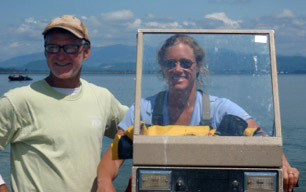As I mentioned previously, the “find” command was a big benefit for me when working with Whit. I could name a location, leave, and Whit would “find” his way back, whether it was a gate in an airport, a poster at a meeting, or our equipment van.
The Seeing Eye now uses clicker training to teach the dogs to find an object or place. I was a bit hesitant, because I knew it was necessary to carry a clicker in one hand (I like to have my right hand free to open doors, carry a drink, or tote my luggage), and to carry a treat bag. I don’t want my guide reliant on treats, and it would be too easy to let her get fat. And I’d have to get a dozen treat bags to match my outfits and shoes (just kidding, smile).
But I am now a convert. I have learned that the dogs can learn to generalize to similar objects. For example, they have been taught to target doorknobs on any door, anywhere. So I decided my first goal would be “trash.” No more wondering what to do with that used pick-up bag in a new city!
The training is based on ABC, just like CPR! But here A=association, B=back training, and C=completion. The A step involves putting a target (in this case a bell on a keychain) on the object or at the location, say a particular doorway. The dog “rings” the bell, gets a click, and then a treat. Repeat about 15 times. Then in part B, back away from the target a few paces, and repeat again. And continue backing away farther and farther. The final step, C, involves removing the target, backing away, identifying the location and praising the dog when they take you to it (no bell or treats). Then we’re done. There’s no need to carry a clicker or treat bag after the 10 minutes it takes to mark a location.
Hugger loves this game! She will ring the bell as often as I’ll let her. She goes up to it, rings it, gets a treat, and tries ringing it again unless I pull her away.
We clicker-identified our dining room seat, and hours later Hugger ran me over there. This is one happy dog! I am now imaging trash cans, crossing buttons, and our car (Whit always would find a car, usually a van which was his favorite, it just wasn’t our car, smile), as well as posters and locations in the field. Hugger will be excited to hear this plan.


